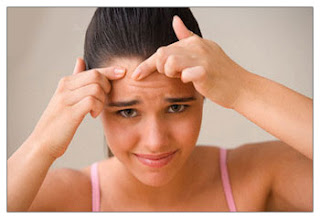 People suffering from acne have a common habit of Popping Pimples especially white heads and black heads in order to get rid of acne faster when it appears in ugly forms on the face. But every dermatologist and beautician advice never to squeeze a pimple but let our body naturally heels a pimple. This is because Popping a Pimple with wrong techniques can lead to negative results like permanent scar formation and new pimple formation that are difficult to remove.
People suffering from acne have a common habit of Popping Pimples especially white heads and black heads in order to get rid of acne faster when it appears in ugly forms on the face. But every dermatologist and beautician advice never to squeeze a pimple but let our body naturally heels a pimple. This is because Popping a Pimple with wrong techniques can lead to negative results like permanent scar formation and new pimple formation that are difficult to remove.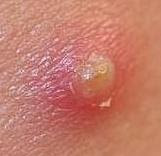 The main reason is when we incorrectly squeeze a pimple the bacteria present into the pores and sebum can easily spread to the adjacent areas of the face or it can probably enters deep into the open pores and thus leading the skin area to become even redder and inflamed with bigger spots. Also never try to squeeze an undeveloped pimple as it may lead to open hole on the face that are difficult to treat.
The main reason is when we incorrectly squeeze a pimple the bacteria present into the pores and sebum can easily spread to the adjacent areas of the face or it can probably enters deep into the open pores and thus leading the skin area to become even redder and inflamed with bigger spots. Also never try to squeeze an undeveloped pimple as it may lead to open hole on the face that are difficult to treat.However Popping Pimples with right techniques can actually be beneficial to the healing process. Following are the steps to pop a pimple properly in order to prevent from unwanted scarring:
Steps or Techniques for Popping Pimples:
Step 1 Wash your Hands:
 Form a habit of washing your hands with some antibacterial soap before popping a pimple in order to minimize the risk of spreading germs in the fresh would or pimple. It is also very important to make sure that your hands and all the other objects in contact with the skin are sterile, disinfected and bacteria free before squeezing a pimple.
Form a habit of washing your hands with some antibacterial soap before popping a pimple in order to minimize the risk of spreading germs in the fresh would or pimple. It is also very important to make sure that your hands and all the other objects in contact with the skin are sterile, disinfected and bacteria free before squeezing a pimple.Step 2 Wash and Steam your Face:
 Wash your face with some antibacterial cleanser. Make a note that the cleanser is pure, gentle, hypoallergenic, non-comedogenic and alcohol free. Then shower your face with warm water in order to dissolve oil, remove dust and kill bacteria on the surface of the skin.
Wash your face with some antibacterial cleanser. Make a note that the cleanser is pure, gentle, hypoallergenic, non-comedogenic and alcohol free. Then shower your face with warm water in order to dissolve oil, remove dust and kill bacteria on the surface of the skin.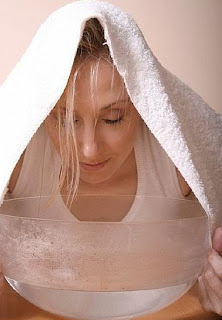 Now steam your face for approximately 10-15 minutes in order to remove oil, bacteria and debris imbedded into your skin. Steaming also widens the clogged pores and softens the skin and thus makes the process of popping of pimples easy.
Now steam your face for approximately 10-15 minutes in order to remove oil, bacteria and debris imbedded into your skin. Steaming also widens the clogged pores and softens the skin and thus makes the process of popping of pimples easy.Step 3 Use gauze pads and Disinfected Needle:
 After you clean your hands and face, wrap a gauze pad around your index fingers to keep the pimple as clean as possible. Never use the tip of your nails as it can damage the skin and can cause intense irritation.
After you clean your hands and face, wrap a gauze pad around your index fingers to keep the pimple as clean as possible. Never use the tip of your nails as it can damage the skin and can cause intense irritation. Also use a sharp, sterile and disinfected needle to minimize the risk of bacterial infection.
Also use a sharp, sterile and disinfected needle to minimize the risk of bacterial infection. Gently prick the top center of the pus filled pimple with the needle. Do not try to puncture a pimple that has no pus formation which means that the pimple has not yet developed completely.
Gently prick the top center of the pus filled pimple with the needle. Do not try to puncture a pimple that has no pus formation which means that the pimple has not yet developed completely.Step 4 Squeeze a Pimple to Release the Pus:
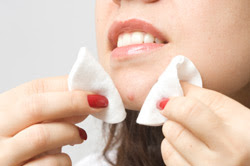 Apply gentle pressure by squeezing your fingers from both side of a pimple in order to remove the pus. Never try to squeeze pus forcefully or violently as it can lead to serious scarring. Try to squeeze pus in one direction – from interior to exterior and not reverse.
Apply gentle pressure by squeezing your fingers from both side of a pimple in order to remove the pus. Never try to squeeze pus forcefully or violently as it can lead to serious scarring. Try to squeeze pus in one direction – from interior to exterior and not reverse. Wipe the pus with sterile cotton balls. Wait for 10 seconds and repeat the squeezing process until you start to see a clear fluid or blood emerging. This is how squeezing can escalate infection. Stop squeezing immediately if blood comes out instead of pus because it is a sign that you have reached a blood vessel.
Wipe the pus with sterile cotton balls. Wait for 10 seconds and repeat the squeezing process until you start to see a clear fluid or blood emerging. This is how squeezing can escalate infection. Stop squeezing immediately if blood comes out instead of pus because it is a sign that you have reached a blood vessel.Step 5 Wash your Face and Apply a Healing Agent:
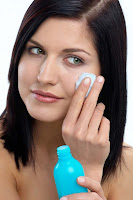 Wash your face with antibacterial cleanser. Now apply a drop of benzoyl-peroxide to a small piece of gauze pad and cover it on popped zit in order to dry the open wound, kill any bacteria inside, shrink enlarged pores and prevent formation of red spots. Rubbing ice cube can also help to shrink the enlarged pores.
Wash your face with antibacterial cleanser. Now apply a drop of benzoyl-peroxide to a small piece of gauze pad and cover it on popped zit in order to dry the open wound, kill any bacteria inside, shrink enlarged pores and prevent formation of red spots. Rubbing ice cube can also help to shrink the enlarged pores.Requirements for Popping Pimples:
Please make a note that you have all the below mentioned items before popping a pimple.
1) Antibacterial Soap
2) Pure, gentle, non-comedogenic face cleanser
3) Warm Water or Steamer
4) Clean Napkin or Paper Towel
5) Sterile Gauze pads
6) Disinfected Needle
7) Sterile Cotton Balls or Swabs
8) Healing agent – benzoyl peroxide
9) Bandages (optional)
10) Ice cube (optional)
Never Pop Cystic Lesions:
 Never try to pop deep, painful, hard acne cysts. But the best option is to see a dermatologist to treat these types of lesions. Doctors administer a cortisone injection which will reduce the swelling and scarring.
Never try to pop deep, painful, hard acne cysts. But the best option is to see a dermatologist to treat these types of lesions. Doctors administer a cortisone injection which will reduce the swelling and scarring.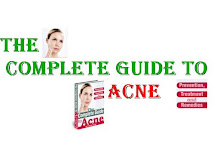
No comments:
Post a Comment